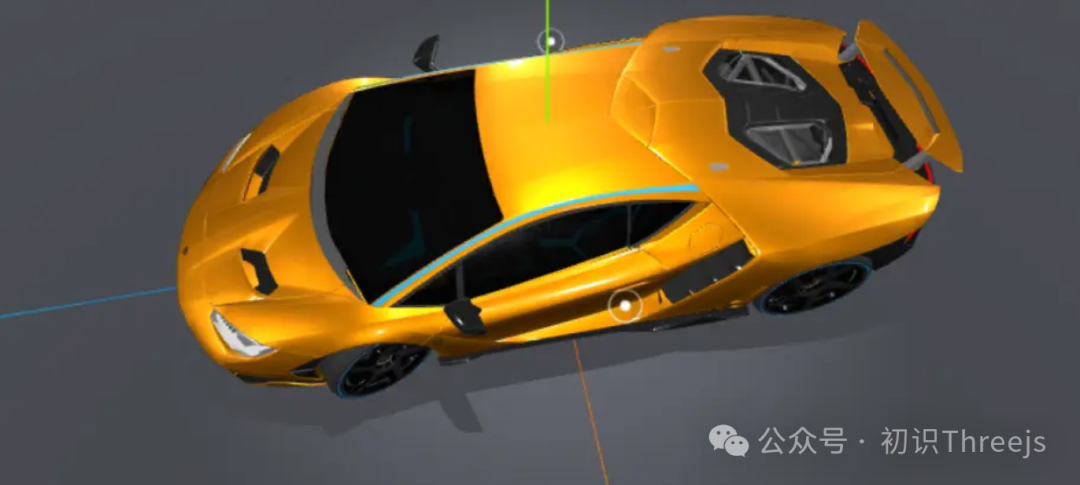
前言
现在很多可视化项目大屏都涉及到了三维, 所以近期学习了一些关于three.js的内容,发现three.js对于小白入门来说还是比较友好的,暂时还没有涉及到webgl相关的。下面的案例用到的都是一些比较基础的,所以对于入门练手来说比较友好的,下面带你实现一下汽车的选购展示。
项目初始化
首先我们初始化一个vite项目
npm create vite@latest
//安装依赖
npm install
//安装three.js
npm install --save three
// 启动项目
npm run dev
接下来就需要我们初始化threejs了,也就是三件套,相机,场景,渲染器
// 初始化 three.js 基础环境
import * as THREE from 'three'
//轨道控制器
import { OrbitControls } from 'three/addons/controls/OrbitControls.js'
export let scene, camera, renderer, controls
// app 标签作为 three.js 的画布容器
const app = document.querySelector('.app')
function init() {
// 创建场景
scene = new THREE.Scene()
// 创建相机 //视野角度 宽高比,远截面 近截面
camera = new THREE.PerspectiveCamera(75, app.clientWidth / app.clientHeight, 0.1, 1000)
// 设置相机的位置
camera.position.set(3, 1.5, 3)
// 创建渲染器 //开启反锯齿
renderer = new THREE.WebGLRenderer({ antialias: true })
// 开启渲染器加载阴影
renderer.shadowMap.enabled = true
// 设置渲染器的宽高
renderer.setSize(app.clientWidth, app.clientHeight)
// 将渲染器添加到 app 标签中
document.querySelector('.app').appendChild(renderer.domElement)
}
function createControls() {
// 创建轨道控制器
controls = new OrbitControls(camera, renderer.domElement)
}
function createHelper() {
// 创建辅助线
const axesHelper = new THREE.AxesHelper(5)
scene.add(axesHelper)
}
function resizeRender() {
// 创建窗口适应
window.addEventListener('resize', () => {
renderer.setSize(app.clientWidth, app.clientHeight)
camera.aspect = app.clientWidth / app.clientHeight
camera.updateProjectionMatrix()
})
}
function renderLoop() {
// 渲染
renderer.render(scene, camera)
controls.update()
requestAnimationFrame(renderLoop)
}
function start() {
init()
createControls()
createHelper()
resizeRender()
renderLoop()
}
// 执行创建再main内导入
start()

这样就可以看到一个三维场景了,现在内部什么都没有,只有一条辅助线,接下来就要进行模型的加载
模型加载
模型加载可以单独封装一个函数,再init时候进行调用添加,添加事件可以封装为一个类,因为后面会涉及到模型的颜色变化,模型的旋转等。
/**
* @param {*} pash 模型文件路径
* @param {*} callback 加载成功回调
*/
//这里引入模型加载器
import { GLTFLoader } from 'three/addons/loaders/GLTFLoader.js'
export function loadManager(pash, callback) {
const loader = new GLTFLoader()
loader.load(
pash,
(e) => {
callback(e)
},
(e) => {
// console.log('加载中', e),
;(e) => {
throw new Error(e)
}
}
)
}
模型加载器是一个附加需要做单独的引入,loadManager函数会接受一个路径和回调函数,当加载成功以后执行回调函数传入加载成功的模型
// 加载汽车模型
loadManager('glb/Lamborghini.glb', (model) => {
new Car(model, scene, camera, controls)
})
Car为单独封装的一个类,后期大部分逻辑都在此处处理,主要包含颜色的切换,视角的切换,材质切换等,这些都需要用到model,直接在模块内进行单独的处理
/**
* @param {*} model 物体
* @param {*} scene 场景
* @param {*} camera 相机
* @param {*} controls 轨道控制器
*/
export class Car {
constructor(model, scene, camera, controls) {
this.model = model
this.scene = scene
this.camera = camera
this.controls = controls
this.init()
}
init() {
// 把车模型加入到场景中
this.scene.add(this.model.scene)
}
}
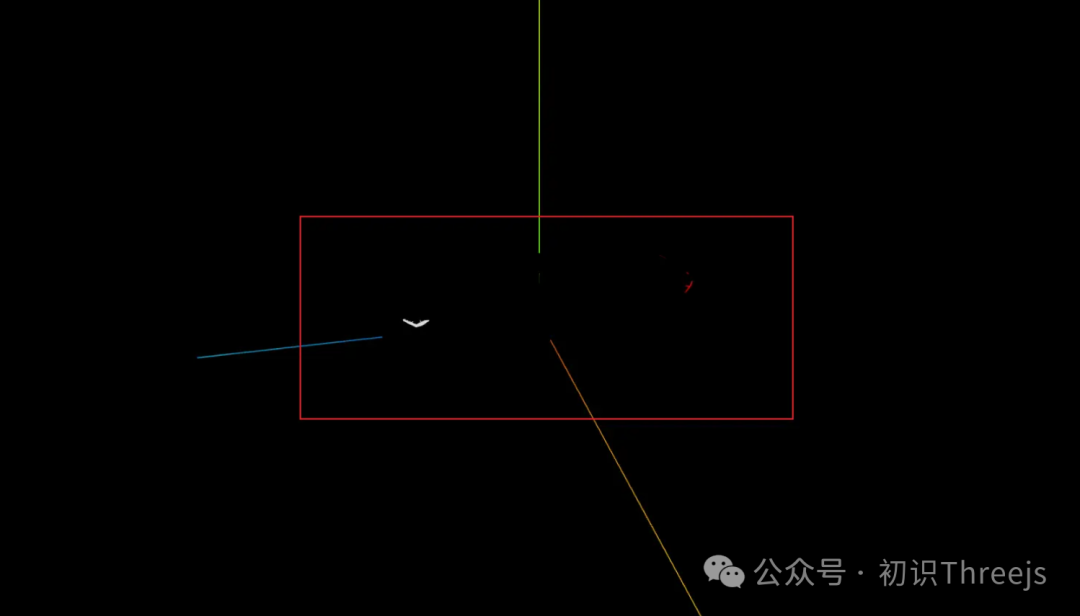
此时模型已经加入到场景内了,全黑色是因为没有灯光,什么也看不到造成的,接下来我们就需要对场景添加灯光
添加灯光
这里我们为灯光封装一个类 MyLigt 在车辆加入到场景内后进行调用添加灯光
// 灯光类
import * as THREE from 'three'
export class MyLight {
constructor(scene) {
this.scene = scene
// 平行光的坐标位置
this.dirPosList = [
[0, 5, 10],
[-10, 5, 0],
[0, 5, -10],
[10, 5, 0]
]
this.init()
}
// 创建照亮汽车的平行光
init() {
//遍历所有位置
this.dirPosList.forEach(positionArr => {
//创建平行光
const directionalLight = new THREE.DirectionalLight(0xffffff, 0.5)
//设置位置
directionalLight.position.set(...positionArr)
this.scene.add(directionalLight)
})
}
}
MyLight在创建模型后进行调用,接收到场景对象,在模型的前后左右创建四个平行光来对车辆进行照亮
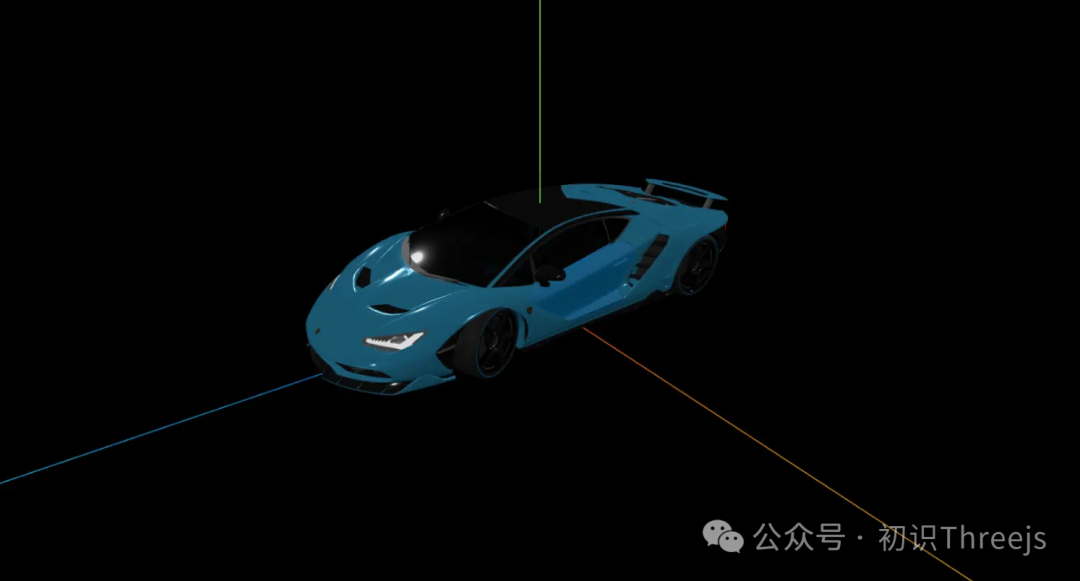
这下我们就可以清楚的看到模型的颜色样子了,初始的模型为蓝色,下面我们添加背景
添加背景
这里我们单独写一个类,用来添加背景,后期又背景的切换直接在类里面进行实现
import * as THREE from 'three'
export class Sky {
constructor(scene) {
this.scene = scene
this.init()
}
// 初始化天空
init() {
// 默认-先创建室内展厅的背景环境
this.createInDoor()
}
// 室内
createInDoor() {
// 球体
const sphereGeo = new THREE.SphereGeometry(10, 32, 16)
const material = new THREE.MeshBasicMaterial({ color: 0x42454c, side: THREE.DoubleSide })
const sphere = new THREE.Mesh(sphereGeo, material)
this.scene.add(sphere)
// 地面
const planeGeo = new THREE.CircleGeometry(10, 32)
const standardMaterial = new THREE.MeshStandardMaterial({ color: 0x42454c, side: THREE.DoubleSide })
const plane = new THREE.Mesh(planeGeo, standardMaterial)
plane.rotation.set(- Math.PI / 2, 0, 0)
plane.receiveShadow = true
this.scene.add(plane)
}
}
室内的场景内主要就是创建一个大的球形包住模型设置颜色为0x42454c再创建一个原型进行旋转90度,做到平放用来当作地面。效果如下:
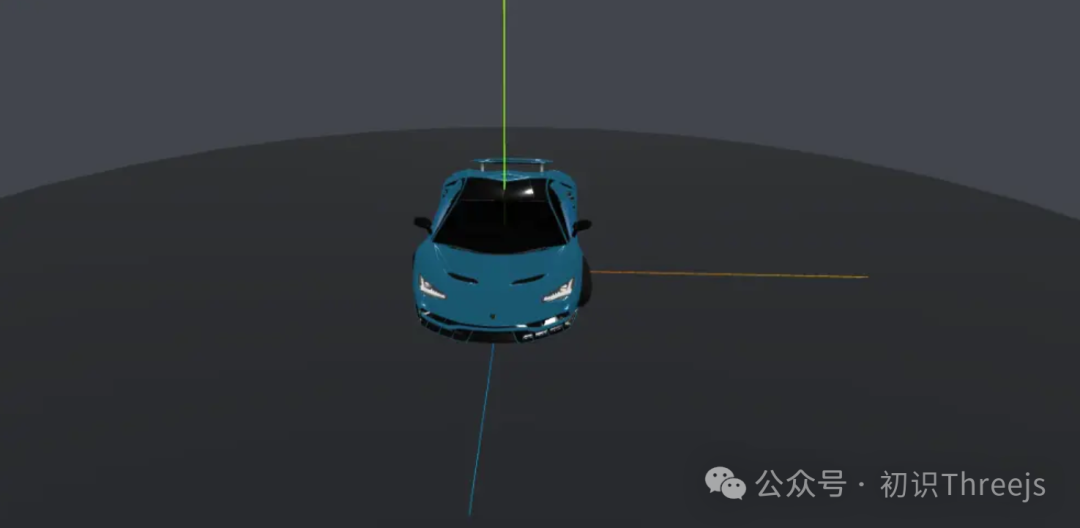
下面需要在车辆上增加两个热点标记来做车门开关的效果
热点标记
热点标记用到的就是three的精灵物体,因为精灵物体的特性的默认行为。使得它在 3D 场景中无论相机如何移动,精灵的正面都会朝向相机。
import * as THREE from 'three'
export class MySprite {
constructor({ name, url, position, scale }) {
const map = new THREE.TextureLoader().load(url)
const material = new THREE.SpriteMaterial({ map: map })
const sprite = new THREE.Sprite(material)
sprite.position.set(...position)
sprite.scale.set(...scale)
sprite.name = name
return sprite
}
}
MySprite接受名称,路径,位置,缩放比例,四个参数,Sprite是没有几何的,只需要创建一个SpriteMaterial进行贴图放入到场景内即可,TextureLoader对图片进行加载
车辆开关效果
上面精灵物体的类以及声明好了,下面就需要进行调用添加到父元素内了,为什么要添加到父元素内呢,因为他需要根据车门的旋转(打开)也进行旋转,那么如何再模型内找到左车门和右车门这个物体呢,就需要用到three里的一个工具了threejs.org/editor/ 在这里把模型到入进行查看

这样就可以知道左侧车门的名称,通过model.getObjectByName(obj.name)就可以拿到这个物体,然后通过mode.add加入到物体内,右侧同理,代码如下
this.carModel = {
'body': {
// ...
'leftDoor': { // 左车门
name: 'Object_64',
model: {},
mark: [
{
name: 'sprite',
url: 'image/sprite.png',
scale: [0.2, 0.2],
position: [1.07, 1.94, -0.23] // 参考车门的原点相对位移
}
]
},
'rightDoor': { // 右车门
name: 'Object_77',
model: {},
mark: [
{
name: 'sprite',
url: 'image/sprite.png',
scale: [0.2, 0.2],
position: [-1.05, 0.78, -0.23]
}
]
}
}
}
init(){
Object.values(this.carModel.body).forEach((obj) => {
obj.model = this.model.getObjectByName(obj.name)
})
}
// 创建车门热点标记
creatdDoorSprite() {
const maskList = [
this.carModel.body.leftDoor,
this.carModel.body.rightDoor,
];
maskList.forEach((obj) => {
obj.mark.forEach((mask) => {
const samll = new MySprite(mask);
// 加入到父节点里 跟随父节点进行动画
obj.model.add(samll);
});
});
}
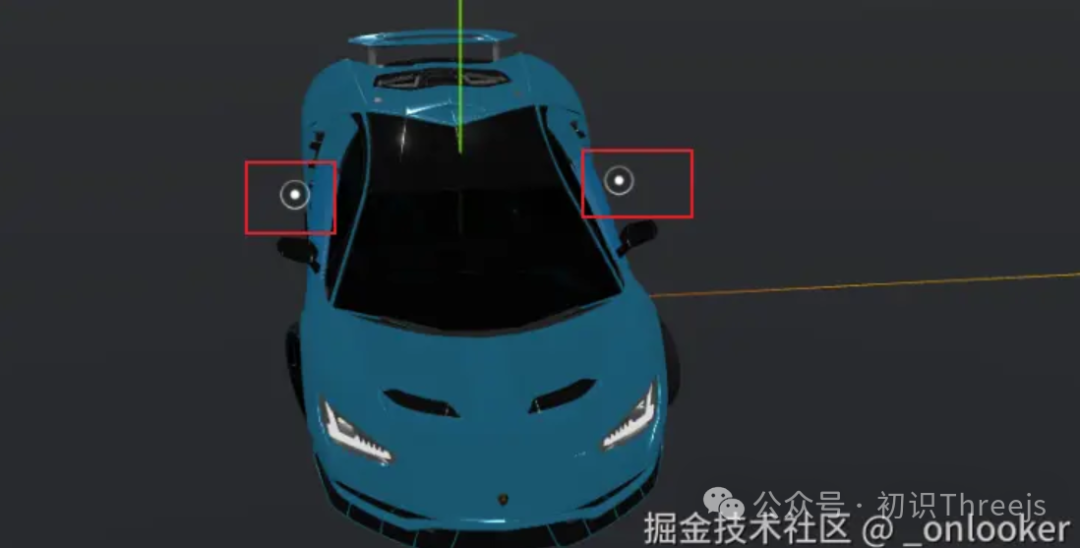
这样车辆得热点标记也就显示出来了,下面就需要声明一个点击事件得函数,点击这个热点标记后对车门进行旋转,做到打开车门的效果
import * as THREE from 'three'
export class ClickHandler {
// 单例类 一个类只有一个实例 外部使用直接调用ClickHandler.getInstance()拿到公用实例
static getInstance() {
if (!this.instance) {
this.instance = new ClickHandler()
}
return this.instance
}
init(camera) {
// 接收传进来的相机 因为光射投影判断点击事件需要用到
this.camera = camera
// 声明一个数组 用来装需要组测点击事件的物体(否则就是遍历整个scene里面的物体数组 ,只遍历有事件的可以提高效率)
this.list = []
// 键值 map的键可以是任何类型 所以物体来标识键 值就是对应要执行的函数
this.map = new Map()
// 创建光射投影
const raycaster = new THREE.Raycaster()
// 二维向量
const pointer = new THREE.Vector2()
// 场景
const app = document.querySelector('.app')
window.addEventListener('click', (event) => {
pointer.x = (event.clientX / app.clientWidth) * 2 - 1
pointer.y = -(event.clientY / app.clientHeight) * 2 + 1
raycaster.setFromCamera(pointer, this.camera)
// 拿到所点击的物体数组
const intersects = raycaster.intersectObjects(this.list)
intersects.forEach((item) => {
// 找到物体对应的函数
const fn = this.map.get(item.object)
// 给回调函数返回无图
fn(item.object)
})
})
}
addMesh(mesh, fn) {
// 添加物体
this.list.push(mesh)
this.map.set(mesh, fn)
}
}
//main.js
import { ClickHandler } from '@/util/Clickhander'
ClickHandler.getInstance().init(camera)
这里使用单例模式,保证只有一个实例类存在,内部list用来存放事件物体map用来存放物体对呀的函数,内部addMesh用来添加物体函数,点击的时候拿到所点击的物体执行内部的函数并传入物体。这样就可以直接在其他地方调用addMesh直接写入物体和对应的函数便可以了。下面就在car内使用一下
creatdDoorSprite() {
const maskList = [
this.carModel.body.leftDoor,
this.carModel.body.rightDoor,
];
maskList.forEach((obj) => {
obj.mark.forEach((mask) => {
const samll = new MySprite(mask);
// 加入到父节点里 跟随父节点进行动画
obj.model.add(samll);
ClickHandler.getInstance().addMesh(samll, (mesh) => {
if (mesh.userData.isShow) {
const clickMesh = mesh.parent.parent.parent;
this.setDoorAnimation(clickMesh, { x: 0 });
mesh.userData.isShow = false;
} else {
// 如果为false则是关闭的 就打开
const clickMesh = mesh.parent.parent.parent;
this.setDoorAnimation(clickMesh, { x: Math.PI / 3 });
mesh.userData.isShow = true;
}
});
});
});
}
setDoorAnimation(mesh, obj) {
gsap.to(mesh.rotation, {
x: obj.x,
duration: 1,
ease: 'power1.inOut',
})
}
}
这里使用ClickHandler.getInstance().addMesh加入两个物体然后再判断mesh.userData.isShow物体内的isShow是否为true,是的话则关闭,否则就是打开,setDoorAnimation主要是使用到了gsap这个库来进行动画效果的过度。这样就实现了下面的效果
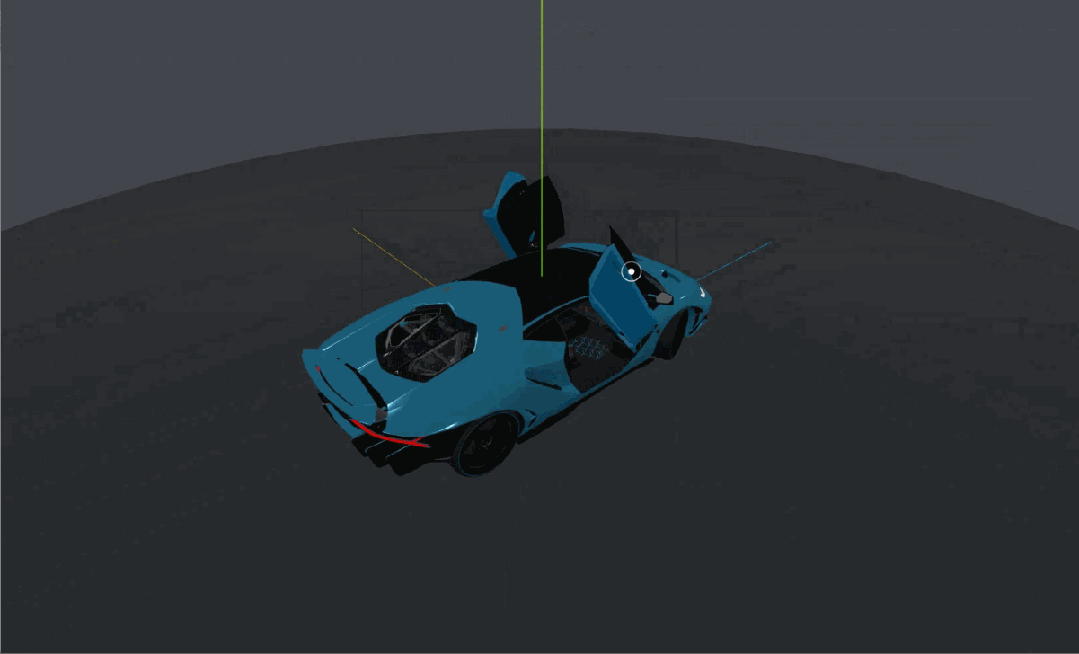
事件总线
后面的颜色修改,贴膜切换及价格修改等都涉及到了跨模块,所以我们需要使用事件总线来进行任务的发布和执行,合理和上面的点击事件的类是有点相似的,也是进行事件的存储和执行
// 事件总线
export class EventBus {
constructor() {
// 声明一个对象 用来装所以的事件名称 和对应的事件
this.eventList = {}
}
// 使用单例模式
static getInstance() {
if (!this.instance) {
this.instance = new EventBus()
}
return this.instance
}
// 用来装入事件
on(eventName, fn) {
// 判断当前事件名是否存在
if (!this.eventList[eventName]) {
// 不存在则创建一个数组啊
this.eventList[eventName] = []
}
// 往当前事件名内 加入事件
this.eventList[eventName].push(fn)
}
emit(eventName, ...args) {
// 调用事件
this.eventList[eventName].forEach((fn) => {
fn(...args)
})
}
}
这个就比较简单了,主要就是使用on来存储一个事件,事件名称作为key,把事件加入到数组内。听过emit来进行取值调用。
颜色修改
我们首先需要创建一个对象,对象内包含我们需要的颜色,颜色的名称,以及是否选中,然后通过上方写好的时间总线来进行注册事件,然后新建dom点击事件来触发颜色的修改逻辑
//car类内声明
this.info = {
price: 2444700,
color: [
{
name: '土豪金',
color: '#ff9900',
isSelected: true,
},
{
name: '传奇黑',
color: '#343a40',
isSelected: false,
},
{
name: '海蓝',
color: '#409EFF',
isSelected: false,
},
{
name: '玫瑰紫',
color: '#6600ff',
isSelected: false,
},
{
name: '银灰色',
color: '#DCDFE6',
isSelected: false,
},
],
// 贴膜
film: [
{
name: '高光',
price: 0,
isSelected: true,
},
{
name: '磨砂',
price: 20000,
isSelected: false,
},
],
}
// 颜色修改init内注册
EventBus.getInstance().on('changeColor', (colorString) => {
// 把模型更换颜色
Object.values(this.carModel.body).forEach((obj) => {
obj.model.material.color = new THREE.Color(colorString)
})
// 把选择的颜色的isSelented 改为true
Object.values(this.info.color).forEach((obj) => {
obj.isSelected = false
if (obj.color == colorString) {
obj.isSelected = true
}
})
})
}
// main.js内注册颜色模块点击事件
let colorStringList = document.querySelectorAll('.col_group>div')
colorStringList.forEach((el) => {
el.addEventListener('click', () => {
EventBus.getInstance().emit('changeColor', el.dataset.col)
})
})
上面通过注册changeColor事件,然后拿到需要改变颜色的模型,对模型的材质颜色进行修改,在main内注册dom点击事件触发changeColor传入要变为的颜色,实现了以下效果:
贴膜切换
贴膜切换和上方的颜色切换其实是一样的,同样的注册事件进行然后点击dom进行事件的触发,只不过是修改材质的粗糙度,和金属度。
// 订阅汽车贴膜修改的事件和函数体
EventBus.getInstance().on('changeMaterial', (coatName) => {
if (coatName === '高光') {
Object.values(this.carModel.body).forEach((obj) => {
obj.model.material.roughness = 0.5
obj.model.material.metalness = 1
obj.model.material.clearcoat = 1
})
} else if (coatName === '磨砂') {
Object.values(this.carModel.body).forEach((obj) => {
obj.model.material.roughness = 1
obj.model.material.metalness = 0.5 // 如果为 0 显得很假
obj.model.material.clearcoat = 0
})
}
// 保存用户选择的贴膜类型
Object.values(this.info.film).forEach((obj) => {
obj.isSelected = false
if (obj.name === coatName) obj.isSelected = true
// 为后面计算总价做准备
})
})
// 注册高光磨砂点击事件 main.js
let lightStringList = document.querySelectorAll('.coat_group>div')
lightStringList.forEach((el) => {
el.addEventListener('click', () => {
// 改变材质
EventBus.getInstance().emit('changeMaterial', el.dataset.co)
})
})
这里的逻辑和上方一样,都是通过事件总线来注册事件,点击DOM来触发函数执行。这里主要是修改材质的粗糙度做到不反光,粗糙度越高反光效果越差
价格计算
// 注册总价改变事件
EventBus.getInstance().on('changeTotalPrice', () => {
const item = this.info.film.find((item) => item.isSelected)
const price = item.price + this.info.allPrice
document.querySelector('.price span').innerHTML = `¥ ${price.toFixed(2)}`
})
lightStringList.forEach((el) => {
el.addEventListener('click', () => {
// 改变材质
EventBus.getInstance().emit('changeMaterial', el.dataset.co)
// 改变总价
EventBus.getInstance().emit('changeTotalPrice')
})
})
这个和上方都是一样的都是通过事件总线来进行触发,动态计算价格
场景切换
上面我们创建的sky内只有一个室内的场景,现在在sky内增加一个户外场景,初始化的时候还是加载室内的场景
import * as THREE from 'three'
import { EventBus } from '@/util/EventBus'
export class Sky {
constructor(scene) {
this.scene = scene
this.noMesh = []
this.SkyName = '展厅' //当前场景名称 默认展厅
this.init()
}
init() {
this.indoor()
EventBus.getInstance().on('changeSky', (skyName) => {
if (this.SkyName == skyName) return //防止是相同的造成重复销毁和新建
this.clear() //先清除现有的物体释放空间
if (skyName == '户外') {
this.outdoor()
this.SkyName = skyName
} else if (skyName == '展厅') {
this.indoor()
this.SkyName = skyName
}
})
}
// 室内场景
indoor() {
// 创建球体
const geometry = new THREE.SphereGeometry(10, 32, 16)
const material = new THREE.MeshBasicMaterial({ color: 0x42454c, side: THREE.DoubleSide })
const sphere = new THREE.Mesh(geometry, material)
this.scene.add(sphere)
this.noMesh.push(sphere)
// 创建地板
const groundGeometry = new THREE.CircleGeometry(10, 32)
const groundMaterial = new THREE.MeshStandardMaterial({
color: 0x42454c,
side: THREE.DoubleSide,
})
const groundSphere = new THREE.Mesh(groundGeometry, groundMaterial)
groundSphere.rotateX(Math.PI / 2)
groundSphere.receiveShadow = true
this.scene.add(groundSphere)
this.noMesh.push(groundSphere)
}
// 户外场景
outdoor() {
// 创建球体
const geometry = new THREE.SphereGeometry(40, 32, 16)
// 户外背景图
const desert = new THREE.TextureLoader().load('image/desert.jpg')
const material = new THREE.MeshBasicMaterial({ map: desert, side: THREE.DoubleSide })
const sphere = new THREE.Mesh(geometry, material)
this.scene.add(sphere)
this.noMesh.push(sphere)
// 创建地板
const sand = new THREE.TextureLoader().load('image/sand.jpg')
const groundGeometry = new THREE.CircleGeometry(20, 32)
const groundMaterial = new THREE.MeshStandardMaterial({
map: sand,
color: 0xa0825a,
side: THREE.DoubleSide,
})
const groundSphere = new THREE.Mesh(groundGeometry, groundMaterial)
groundSphere.rotateX(Math.PI / 2)
this.scene.add(groundSphere)
this.noMesh.push(groundSphere)
}
// 清除物体
clear() {
this.noMesh.forEach((obj) => {
obj.material.dispose()
obj.geometry.dispose()
obj.material.map && obj.material.map.dispose()
obj.parent.remove(obj)
})
this.noMesh.splice(0, this.noMesh.length)
}
}
这里我们初始化的时候默认加载室内的场景,然后通过事件总线来进行触发切换。室外场景和室内场景其实都是一个圆球,只不过室外场景在材质上进行了贴图,然后每次事件触发我们先判断是否为当前场景,如果是的话直接return就可以了,避免性能浪费,如果不是的话则清除当前场景物体,创建新的场景物体。
视角切换
接下来咱们就可以坐到车里唠了。视角切换的话主要就是拿到车内的视角的相机位置,我们可以通过注册轨道控制器的change事件来拿到所需要的观察点位和相机位置
// 汽车各种视角坐标对象
this.positionObj = {
// 主驾驶
main: {
camera: {
x: 0.36,
y: 0.96,
z: -0.16,
},
controls: {
x: 0.36,
y: 0.87,
z: 0.03,
},
},
// 副驾驶位
copilot: {
camera: {
x: -0.39,
y: 0.87,
z: 0.07,
},
controls: {
x: -0.39,
y: 0.85,
z: 0.13,
},
},
// 外面观察
outside: {
camera: {
x: 3,
y: 1.5,
z: 3,
},
controls: {
x: 0,
y: 0,
z: 0,
},
},
}
// 注册视角切换事件
EventBus.getInstance().on('changeCamera', (cameraType) => {
this.setCameraAnimation(this.positionObj[cameraType])
})
// 摄像机和轨道控制器动画
setCameraAnimation(obj) {
// 相机
gsap.to(this.camera.position, {
...obj.camera,
duration: '1',
ease: 'power1.inOut',
})
// 轨道控制器
gsap.to(this.controls.target, {
...obj.controls,
duration: '1',
ease: 'power1.inOut',
})
}
}
通过change拿到不同视角的信息后通过setCameraAnimation修改相机的位置和轨道控制器的观察点位,就可以进行视角的切换:
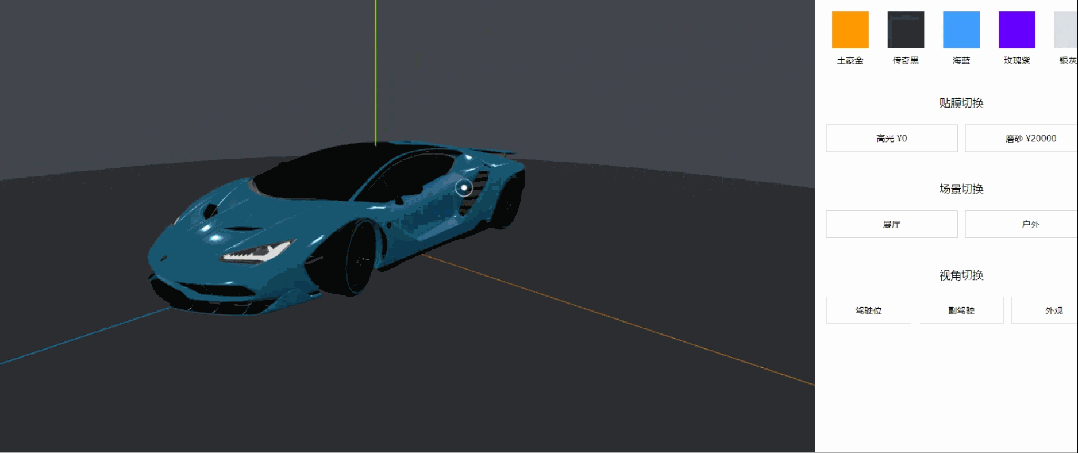
玻璃透视效果
现在模型的顶棚是单面渲染需要改为双面渲染,玻璃是双面渲染需要修改为单面渲染,找到所有的玻璃物体和顶棚物体,修改他们的side
// 车小模型对象
this.carModel = {
'body': {
// ...
},
'glass': { // 玻璃
'front': { // 前玻璃
name: 'Object_90',
model: {}
},
'leftGlass': { // 左玻璃
name: 'Object_68',
model: {}
},
'rightGlass': { // 右玻璃
name: 'Object_81',
model: {}
}
}
}
//在 model/Car.js 的 init 方法,找到小物体保存
// 玻璃相关
Object.values(this.carModel.glass).forEach(obj => {
// 通过名字找到小物体
obj.model = this.model.getObjectByName(obj.name)
})
// 更改模型改材质颜色 //初始化模型时调用
modifyCarBody() {
// 更改模型默认颜色
Object.values(this.carModel.body).forEach((obj) => {
obj.model.material = new THREE.MeshPhysicalMaterial({
color: 0xff9900,
roughness: 0.5,
metalness: 1,
clearcoat: 1,
clearcoatRoughness: 0,
})
})
// 更改模型玻璃为单面渲染
Object.values(this.carModel.glass).forEach((obj) => {
obj.model.material.side = THREE.FrontSide //改为单面渲染
})
// 车顶改为双面渲染
this.carModel.body.roof.model.material.side = THREE.DoubleSide
}
通过修改玻璃和顶棚的渲染面现在就可以清晰的看到外面了:

聚光灯阴影效果
首先我们先实现一个聚光灯的创建,然后让模型内的每个小都设置castShadow为true开启阴影渲染,且渲染器开启了阴影的加载
this.nowSpotLight = {} // 聚光灯光源对象
this.createSportL()
// 创建聚光灯
createSportL() {
this.nowSpotLight = new THREE.SpotLight(0xffffff, 1)
this.nowSpotLight.angle = 0.16 * Math.PI // 设置聚光灯光源角度(0 - Math.PI / 2)
this.nowSpotLight.penumbra = 1 // 光的衰减程度(0 - 1)
this.nowSpotLight.castShadow = true // 开启阴影支持
this.nowSpotLight.shadow.mapSize.set(4096, 4096)//阴影贴图大小宽高
this.nowSpotLight.position.set(0, 5, 0)
this.scene.add(this.nowSpotLight)
}
// 遍历所有子项开启阴影
this.model.scene.traverse((obj) => {
obj.castShadow = true
console.log(obj.castShadow)
})
首先我们创建一个聚光灯加入到场景内,并且设置聚光灯开启阴影效果,然后遍历模型内所有的小物体都开启阴影支持,这个时候我们就已经可以看到车辆的阴影了
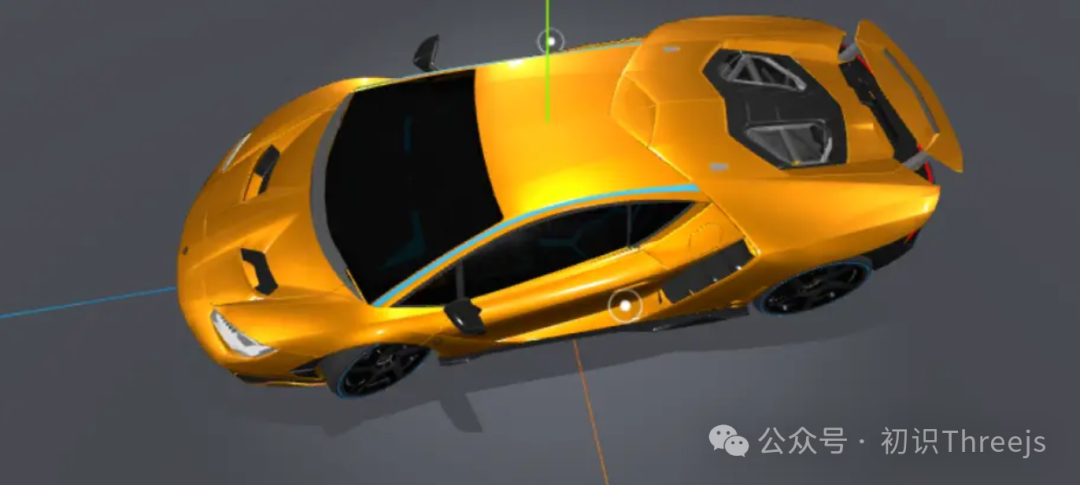
聚光灯的切换
我们默认只有室内才有聚光灯,所有在切换场景的时候需要把聚光灯给删除。先声明一个删除聚光灯的函数,然后再通过事件总线注册事件,再切换场景的时候进行触发,删除聚光灯效果
EventBus.getInstance().on('changeSky', (skyName) => {
if (this.nowSpotName == skyName) return
if (skyName == '展厅') {
this.createSportL()
} else if (skyName == '户外') {
this.removeSportL()
}
this.nowSpotName = skyName
})
// 删除聚光灯
removeSportL() {
this.nowSpotLight.dispose() //释放空间
this.scene.remove(this.nowSpotLight)
this.nowSpotLight = {}
}
先判断当前场景和要切换的场景是否一致,一致的话则直接return,如果不一致的话为户外再删除聚光灯,室内则创建聚光灯。然后复制当前的场景name为传入的skyName
效果总览
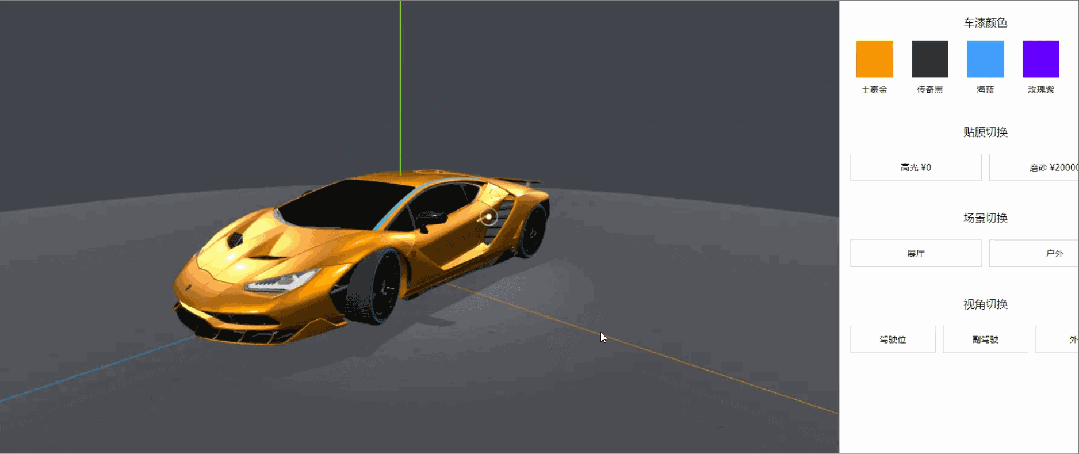
结尾
这个小案例主要包含了汽车模型和灯光的加载,颜色切换,贴膜切换,场景切换,镜头切换,价格统计等。涉及到的都是一些three的基础入门api,非常适用于入门练习
























 2506
2506

 被折叠的 条评论
为什么被折叠?
被折叠的 条评论
为什么被折叠?










